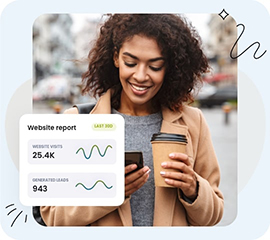When customers know your business’s availability, you reap the benefits. Showing your business hours builds trust with visitors, shows better customer service, and will also help your search engine ranking. Website Builder makes setting your business hours easy and convenient.
To learn how to access your Website Builder to get started, please visit this article.
In this Knowledge Base article, HostPapa helps you set your business hours. This action will prevent missed sales, customer frustration, and a decline in trust in your business. At the end of this article, HostPapa will also give you nine tips regarding business hours!
Setting your business hours in Website Builder
- Select the Open business days.
- Check the days (checkbox) your business will be open and manually enter the times.
- Toggle to Holiday Hours.
- Enter (manually) the days your business is closed.
- Select Add Closed Date.
- Select Show Hours Table to display your business hours within the Booking button.
- Click Next.
9 Tips for setting and managing business hours
Setting the right business hours is more than just picking times to open and close. It’s about aligning your availability with customer needs, perfecting operations, and presenting a professional image across all platforms. Here are nine detailed tips to help you set, display, and update your business hours for maximum impact.
1. Understand your target customer
- Research when your primary customers prefer to shop or interact.
- Use surveys or gather data from sales and foot traffic to identify peak periods.
- Example: If your audience is working professionals, consider extending hours into the evening. You can also open on weekends to accommodate their schedules.
2. Analyze peak shopping and service hours
- Audit your data regularly to discover when your business is the busiest.
- Adjust operating hours to match demand and raise productivity.
- Tip: Utilize point-of-sale systems or website analytics. They can help you to identify busy periods and adjust hours or staff schedules accordingly.
3. Monitor competitor business hours
- Study when your competitors are open and consider aligning or differentiating your schedule to capture a market share.
- Example: If competitors close early, experiment with staying open later to attract more customers.
4. Consider employee wellbeing and staffing needs
- Balance your business hours with realistic staffing levels and employee wellness.
- Prevent burnout by scheduling adequate breaks and respecting work-life boundaries.
- Tip: If extended hours are necessary, consider rotating shifts or offering flexible scheduling.
5. Adapt to seasonal trends and holidays
- Change your business hours during holidays, seasonal peaks, and special events.
- Stay open longer during high-traffic periods (such as Christmas or back-to-school seasons). Adjust your hours to slow down when demand drops.
- Always communicate these changes in advance to avoid customer confusion.
6. Leverage technology for better management
- Employ scheduling tools, website plugins, or point of sale (POS) systems that automate tracking and updating business hours.
- Set up automatic reminders to review and update hours regularly, especially ahead of holidays or events.
7. Display hours prominently and consistently
- List your business hours in a clear and visible section on your website and across all digital platforms.
- Use a table or weekly overview for improved readability. Include information about special days or closures directly adjacent to your regular hours.
- Check the hours match on your website, Google Business Profile, and social media. Doing so will build customer trust.
8. Update business hours regularly
- Set monthly or quarterly reminders to review your hours and update all platforms simultaneously.
- Pay special attention before holidays or seasonal changes. If there is a temporary closure or emergency, please reflect it immediately on all platforms where your hours are posted.
- Monitor customer feedback and act quickly if customers report conflicting or incorrect times.
9. Communicate clearly and professionally
- Use simple, concise language for business hours (for example, Monday through Friday: 9:00 AM—6:00 PM).
- Avoid jargon or complicated terms—make it easy for anyone to understand.
- Specify different hours for additional services (for example, delivery vs. in-store), and distinguish between regular and holiday hours.
| Quick reference table |
| Tip | Example |
| Know your audience: | Survey customers to discover preferred shopping times. |
| Analyze peak hours: | Use POS or web analytics for busiest times. |
| Watch competitors: | Adjust to capture traffic missed by competitors. |
| Staff smartly: | Balance shifts to avoid burnout. Promote a healthy work-life balance. |
| Adjust for seasons: | Stay open longer during holidays, reduce during slow periods. |
| Use technology: | Automate reminders and hours updates. |
| Display hours clearly: | Website, Google, and social media must all show the same hours. |
| Update often: | Set recurring reminders and respond to customer feedback. |
| Communicate professionally: | Simple, consistent language and context for different services. |
Key takeaways
- Setting the right hours begins with data: Know your customers and monitor your patterns.
- Technology can automate and streamline management.
- Consistency, clarity, and frequent updates: Build trust and improve your business’s reputation.
Using these nine tips, your business will be more accessible and trustworthy for customers—helping you stand out and succeed in any industry.
If you need help with your HostPapa account, please open a support ticket from your dashboard.
